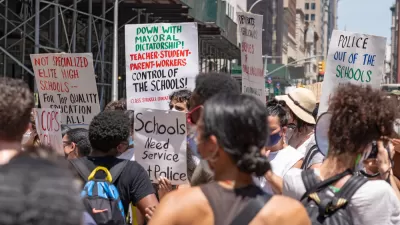Most policies regarding poverty are driven by obsolete metrics. Another model, which measures the very basic needs for survival, reveals deep poverty in New York City.
Jilly Stephens explains the difficulty in quantifying poverty in the United States, which makes it difficult to create policies and programs to combat the causes and effects of poverty.
For instance:
The federal poverty threshold, which was developed over five decades ago and is based on what the estimated food costs were for a family at that time, has been widely criticized as being outdated and flawed. Meanwhile, the New York City poverty number, which is calculated by the City’s Center for Economic Opportunity, takes into account all of a family’s expenses, including housing and resources such as government benefits. While the New York poverty number is a closer reflection of how people live, it’s still not the most accurate measurement.
As an antidote to "cookie-cutter standards, Stewart introduces the Self-Sufficiency Standard, as developed by the Center for Women’s Welfare. According to Stewart's explanation, "[developed] by the Center for Women’s Welfare, the standard examines the income necessary for families to afford basic needs—such as food, shelter, clothing and transportation—in various cities and states without public assistance. It identifies what it takes for a family to simply survive, not thrive."
Stewart goes on to provide insight into the 2014 Self-Sufficiency Standard for New York—a shocking 42 percent of households do not meet the standard.
FULL STORY: The US doesn’t have a good way of determining who’s poor

Alabama: Trump Terminates Settlements for Black Communities Harmed By Raw Sewage
Trump deemed the landmark civil rights agreement “illegal DEI and environmental justice policy.”

Planetizen Federal Action Tracker
A weekly monitor of how Trump’s orders and actions are impacting planners and planning in America.

The 120 Year Old Tiny Home Villages That Sheltered San Francisco’s Earthquake Refugees
More than a century ago, San Francisco mobilized to house thousands of residents displaced by the 1906 earthquake. Could their strategy offer a model for the present?

In Both Crashes and Crime, Public Transportation is Far Safer than Driving
Contrary to popular assumptions, public transportation has far lower crash and crime rates than automobile travel. For safer communities, improve and encourage transit travel.

Report: Zoning Reforms Should Complement Nashville’s Ambitious Transit Plan
Without reform, restrictive zoning codes will limit the impact of the city’s planned transit expansion and could exclude some of the residents who depend on transit the most.

Judge Orders Release of Frozen IRA, IIJA Funding
The decision is a victory for environmental groups who charged that freezing funds for critical infrastructure and disaster response programs caused “real and irreparable harm” to communities.
Urban Design for Planners 1: Software Tools
This six-course series explores essential urban design concepts using open source software and equips planners with the tools they need to participate fully in the urban design process.
Planning for Universal Design
Learn the tools for implementing Universal Design in planning regulations.
Clanton & Associates, Inc.
Jessamine County Fiscal Court
Institute for Housing and Urban Development Studies (IHS)
City of Grandview
Harvard GSD Executive Education
Toledo-Lucas County Plan Commissions
Salt Lake City
NYU Wagner Graduate School of Public Service




























